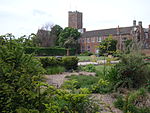Cannington Camp

Cannington Camp is a Bronze Age and Iron Age hill fort near Cannington, Somerset, England. It is a Scheduled Ancient Monument.The small hill rises to 80 metres (260 ft) above low-lying land about 1.5 kilometres (0.93 mi) west of the tidal estuary of the River Parrett, near the ancient port and ford at Combwich. The hill fort is roughly square in shape, with a single rampart (univallate) enclosing 5 ha (12 acres), and the main entrance to the south-east. The north side of the hill has been destroyed by quarrying during the 19th and 20th centuries. Minor excavations were carried out in 1905, 1913 (Bezell), and 1963 (Rahtz). Flint tools, scrapers and flakes have been found on or near the hill, indicating Mesolithic occupation. Bronze Age finds include an axe head and a knife. The area destroyed by quarrying was a late Roman and Saxon cemetery, with several hundred E-W (Christian) graves, and various grave goods such as coins and pottery from the period 350-800 AD. It is possibly the site of Cynwit Castle (or Cynuit, Cynwith, Cynwits, etc.) and the Battle of Cynwit between Saxons and Vikings in 878 AD (see map). It may also be the location of an earlier battle in 845 AD, when the Saxons were led by Eanwulf and Ealstan, Bishop of Sherborne.
Excerpt from the Wikipedia article Cannington Camp (License: CC BY-SA 3.0, Authors, Images).Cannington Camp
Stradling's Hill,
Geographical coordinates (GPS) Address Nearby Places Show on map
Geographical coordinates (GPS)
| Latitude | Longitude |
|---|---|
| N 51.159166666667 ° | E -3.0808333333333 ° |
Address
Stradling's Hill
TA5 2QD , Cannington
England, United Kingdom
Open on Google Maps










